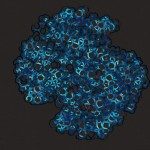Link to Pubmed [PMID] – 20616068
Proc. Natl. Acad. Sci. U.S.A. 2010 Jul;107(29):13081-6
Many gram-negative bacteria secrete specific proteins via the type II secretion systems (T2SS). These complex machineries share with the related archaeal flagella and type IV pilus (T4P) biogenesis systems the ability to assemble thin, flexible filaments composed of small, initially inner membrane-localized proteins called “pilins.” In the T2SS from Klebsiella oxytoca, periplasmic pseudopili that are essential for pullulanase (PulA) secretion extend beyond the bacterial surface and form pili when the major pilin PulG is overproduced. Here, we describe the detailed, experimentally validated structure of the PulG pilus generated from crystallographic and electron microscopy data by a molecular modeling approach. Two intermolecular salt bridges crucial for function were demonstrated using single and complementary charge inversions. Double-cysteine substitutions in the transmembrane segment of PulG led to position-specific cross-linking of protomers in assembled pili. These biochemical data provided information on residue distances in the filament that were used to derive a refined model of the T2SS pilus at pseudoatomic resolution. PulG is organized as a right-handed helix of subunits, consistent with protomer organization in gonococcal T4P. The conserved character of residues involved in key hydrophobic and electrostatic interactions within the major pseudopilin family supports the general relevance of this model for T2SS pseudopilus structure.

